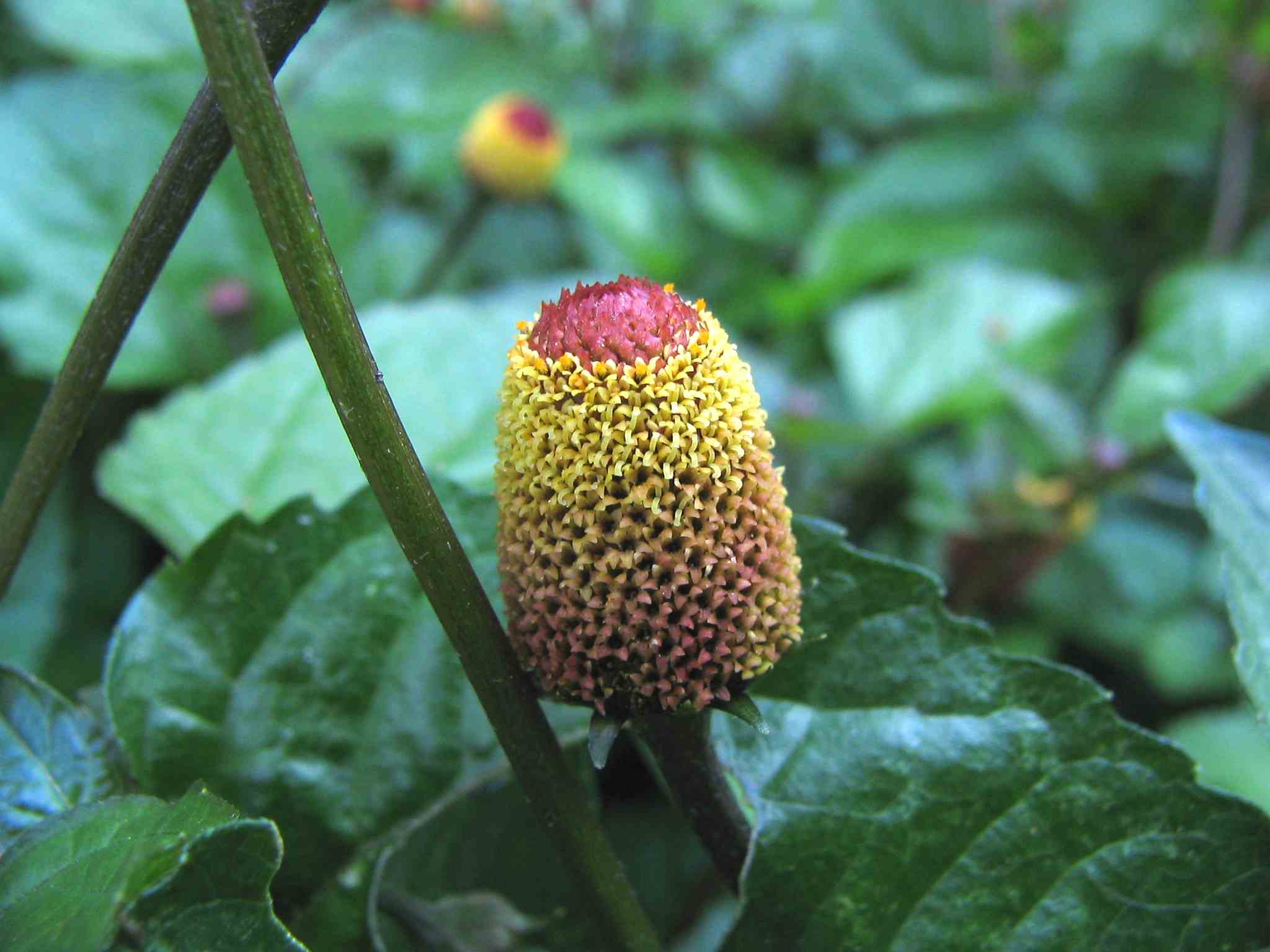- Acmella oleracea
Taxobox
name = "Acmella oleracea"

image_width = 240px
image_caption = "Acmella oleracea" inflorescence
regnum =Plant ae
divisio = Magnoliophyta
classis = Magnoliopsida
ordo =Asterales
familia =Asteraceae
genus = "Acmella "
species = "A. oleracea"
binomial = "Acmella oleracea"
binomial_authority = (L.) R.K.Jansen"Acmella oleracea", also known under its old names "Spilanthes oleracea" and "Spilanthes acmella", is a flowering herb in the plant family "
Asteraceae ", also known as toothache plant or paracress as the leaves and flower heads contain ananalgesic agentspilanthol used to numb toothache. It is native to the tropics ofBrazil , and is grown as an ornamental (and occasionally as a medicinal) in various parts of the world. A small, erect plant, it grows quickly and sends up gold and red flower inflorescences. It is frost-sensitive but perennial in warmer climates.Synonyms
*"Spilanthes oleracea" L. (1767)
*"Spilanthes acmella" auct. non (L.) Murr.For more information on synonyms, see the [http://gmr.landfood.unimelb.edu.au/Sorting/Spilanthes.html Plant Name Database entry] on "
Spilanthes ".Vernacular names
The English common name, toothache plant, is synonymous with the Swedish common name "tandvärksplanta"; both stem from the analgesic alkylamides the plant contains. The name paracress is in reference to the Northern
Brazil statePará .It is known in French as brède mafane and cresson de Para, and in Portuguese as agrião do Pará and jambú.Grubben, G.J.H. & Denton, O.A. (2004) Plant Resources of Tropical Africa 2. Vegetables. PROTA Foundation, Wageningen; Backhuys, Leiden; CTA, Wageningen.]
Culinary uses
For culinary purposes, small amounts of shredded fresh leaves add a unique flavour to salads. Cooked leaves lose their strong flavour and may be used as
leafy greens . Both fresh and cooked leaves are used in dishes in parts of Brazil, often combined with chillies andgarlic to add flavor and vitamins to other foods. A related species is used in several Southeast Asian dishes. Consumption of portions or whole flowers have been reportedly used to offset the intense heat of chillies and peppers.Popular uses
A decoction or infusion of the leaves and flowers is recommended for stammering, toothache, stomatitis and throat complaints. Eating a whole flower bud results in an extremely strong tingling sensation accompanied by excessive saliva production.
Properties
The most important taste-active molecules present are the alkamides and especially, (2E,6Z,8E)-deca-2,6,8-trienoic acid N-isobutyl amide or spilanthol,
[

which is responsible for the trigeminal and saliva-inducing effects of products such as Jambu oleoresin, a concentrated extract from Paracress.cite journal |author=Ramsewak RS, Erickson AJ, Nair MG |title=Bioactive N-isobutylamides from the flower buds of Spilanthes acmella |journal=Phytochemistry |volume=51 |issue=6 |pages=729–32 |year=1999 |pmid=10389272 |doi=]
Extracts using hexane of freshly harvested flowers of S. acmella were bioassayed against A. aegyptii larvae andH. zea (corn earworm) neonates. Mosquitocidal assays on A. aegyptii using spilanthol indicated that they were very active.Spilanthol had a LD100 (24 h) at 12.5 µg/mL concentrations and showed 50% mortality at 6.25 µg/mL.
The mixture of
isomer s of spilanthol showed a 66% weight reduction of H. zea neonate larvae at 250 µg/mL concentration after 6 days.cite journal |author=Ramsewak RS, Erickson AJ, Nair MG |title=Bioactive N-isobutylamides from the flower buds of Spilanthes acmella |journal=Phytochemistry |volume=51 |issue=6 |pages=729–32 |year=1999 |pmid=10389272 |doi=]"Acmella oleracea" has also been shown to have a strong
diuretic action in rats.cite journal |author=Ratnasooriya WD, Pieris KP, Samaratunga U, Jayakody JR |title=Diuretic activity of Spilanthes acmella flowers in rats |journal=Journal of ethnopharmacology |volume=91 |issue=2-3 |pages=317–20 |year=2004 |pmid=15120455 |doi=10.1016/j.jep.2004.01.006]Acmella oleracea extract has been tested against various yeasts and bacteria and was essentially inactive.cite journal |author=Holetz FB, Pessini GL, Sanches NR, Cortez DA, Nakamura CV, Filho BP |title=Screening of some plants used in the Brazilian folk medicine for the treatment of infectious diseases |journal=Mem. Inst. Oswaldo Cruz |volume=97 |issue=7 |pages=1027–31 |year=2002 |pmid=12471432 |doi=]
Besides the main active ingredient spilanthol, "Acmella" also contains stigmasteryl-3-"O"-"b"-D-glucopyranoside and a mixture of
triterpene s.The isolation and total synthesis of the active ingredients have been reported.cite journal |author=Ley JP, Blings M, Krammer G, Reinders G, Schmidt CO, Bertram HJ |title=Isolation and synthesis of acmellonate, a new unsaturated long chain 2-ketol ester from Spilanthes acmella |journal=Nat. Prod. Res. |volume=20 |issue=9 |pages=798–804 |year=2006 |pmid=16753916 |doi=10.1080/14786410500246733]
References
External links
* [http://database.prota.org/dbtw-wpd/exec/dbtwpub.dll?AC=QBE_QUERY&BU=http%3A%2F%2Fdatabase.prota.org%2Fsearch.htm&TN=PROTAB~1&QB0=AND&QF0=Species+Code&QI0=Acmella+oleracea&RF=Webdisplay PROTAbase on "Acmella oleracea"]
Wikimedia Foundation. 2010.
